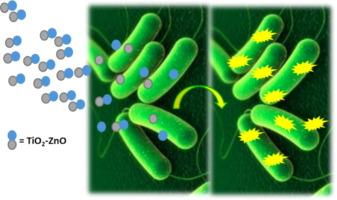Green synthesis of TiO2/ZnO heterostructure using Urtica Smensis leaf extract for antibacterial activity
IF 2.5
Q2 CHEMISTRY, MULTIDISCIPLINARY
引用次数: 0
Abstract
An environmentally friendly and low-cost green approach currently gets great attention in medicinal fields. In the present work, we have successfully synthesized TiO2/ZnO heterostructure (TZH) by using the aqueous extract of Urtica Simensis (U. Simensis) leaf as a reducing and capping agent for the first time. The synthesized TiO2 and ZnO nanoparticles (NPs) and TZH were characterized by different characterization techniques. The XRD analysis verified the crystallinity and nanoscale crystallite size (12 nm) of the TZH. The TEM/HRTEM analysis verified the nanoscale particle size (36 nm) and formation of TiO2/ZnO interface within TZH. From the nitrogen adsorption–desorption isotherm analysis, the specific surface area, pore size, and pore volume of TZH were found to be 89.6 m2/g, 6.8 nm, and 0.054 cm3/g, respectively. The antibacterial potential of TiO2/ZnO was found to be the highest compared to both pristine TiO2 and ZnO for all four bacterial strains of S. aureus, S. pyogenes, P. aeruginosa, and E. coli. The maximum zones of inhibition of TZH were found to be 20.1, 21.3, 19.4, and 18.5 mm for S. pyogenes, S. aureus, E. coli, and P. aeruginosa, respectively. With this result, the green synthesis approach has a great future outlook for an antimicrobial application.

利用荨麻叶提取物绿色合成具有抗菌活性的 TiO2/ZnO 异质结构
目前,一种环境友好且成本低廉的绿色方法在医药领域备受关注。在本研究中,我们首次使用荨麻叶的水提取物作为还原剂和封端剂,成功合成了 TiO2/ZnO 异质结构(TZH)。通过不同的表征技术对合成的 TiO2 和 ZnO 纳米粒子(NPs)和 TZH 进行了表征。XRD 分析证实了 TZH 的结晶度和纳米级结晶尺寸(12 nm)。TEM/HRTEM 分析证实了 TZH 的纳米级粒度(36 nm)和 TiO2/ZnO 界面的形成。通过氮吸附-解吸等温线分析发现,TZH 的比表面积、孔径和孔体积分别为 89.6 m2/g、6.8 nm 和 0.054 cm3/g。对于金黄色葡萄球菌、化脓性葡萄球菌、铜绿假单胞菌和大肠杆菌这四种细菌菌株,TiO2/ZnO 的抗菌潜力均高于纯净的 TiO2 和 ZnO。化脓性链球菌、金黄色葡萄球菌、大肠杆菌和铜绿假单胞菌对 TZH 的最大抑菌区分别为 20.1、21.3、19.4 和 18.5 毫米。由此可见,这种绿色合成方法在抗菌方面的应用前景十分广阔。
本文章由计算机程序翻译,如有差异,请以英文原文为准。
求助全文
约1分钟内获得全文
求助全文

 求助内容:
求助内容: 应助结果提醒方式:
应助结果提醒方式:


